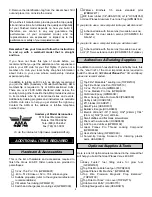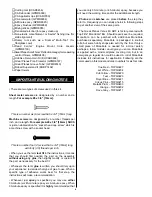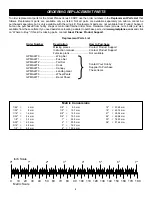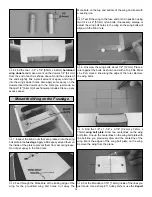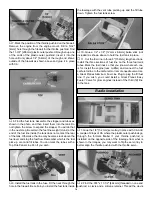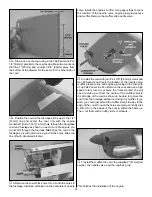
❏ ❏
13. Cut up a servo arm as shown above, attach it to
the servo and center it so that the servo arm is 90 degrees
to the pushrod. Center the aileron and mark on the pushrod
where it meets with the servo arm’s hole. Enlarge the hole
on the servo arm with a Hobbico Servo Horn Drill (or a #48
or 5/64" [2mm] drill bit). Bend the pushrod 90 degrees up
and install a FasLink as shown in the sketch above. Cut
away any excess wire, leaving 1/16" [1.6mm] protruding
from the FasLink.
❏
14. If you have not done so, go back to step 1 and finish
the left wing the same way.
❏
1. Tape the servo leads to the top of the wing to keep
them out of the way when joining the wing panels. Test fit the
wing halves with the hardwood joiner. Be certain that the
dihedral angle on the wing joiner is pointing towards the
bottom of the wing. You may need to sand the joiner slightly
to obtain a perfect fit.
❏
2. The following are critical steps in the construction of
your model. You want to make sure you take as much time
as necessary to glue the two wings together correctly. Epoxy
should be used generously in each one of the following
steps. Use 30-minute epoxy to allow enough time to fit the
parts and to wipe off the excess glue with denatured alcohol
and a paper towel.
❏
3. Prepare 3/4 oz [22cc] of 30-minute epoxy. Apply epoxy
to the right wing’s wing joiner pocket and to the right side of
the wing joiner. Insert the wing joiner into the pocket. Apply
epoxy to the other half of the wing joiner, the left wing’s wing
joiner pocket and both root ribs. Hold both wings together
tightly. Clean up any excess epoxy that squeezes out. Use
masking tape to hold both wings together until the epoxy
has cured. Again, wipe off any excess epoxy with alcohol
and a paper towel. Set the wing aside and do not disturb
until the epoxy has cured.
Note: If the panels are joined correctly and the fit is tight,
you should obtain the correct dihedral. If you would like to
check it, set the bottom of one wing flat against your
working surface. The bottom of the other wing tip should be
raised 2-3/16" [55.5mm] from your working surface.
Join the Wing
CUT OFF
UNUSED ARMS
ENLARGE TO
5/64"
9



